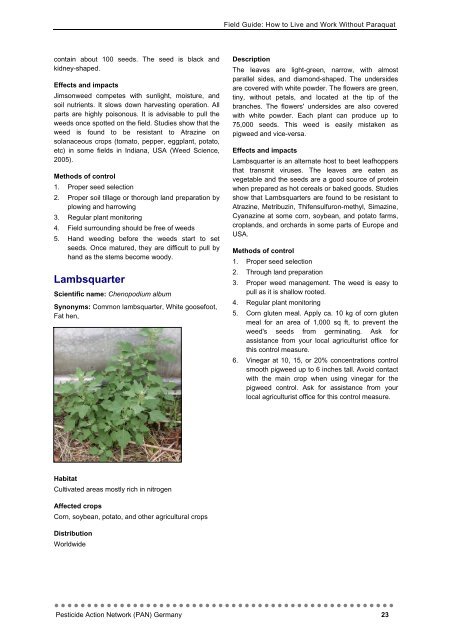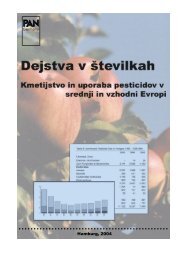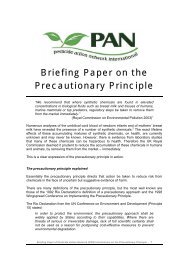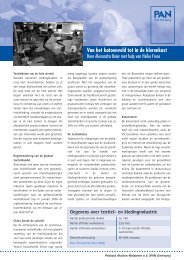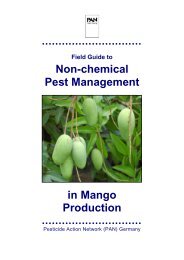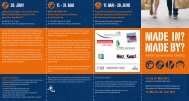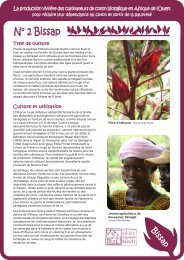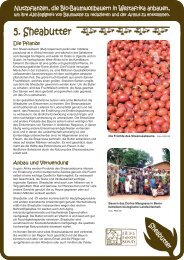Field Guide: How to Grow Crops without Paraquat - Online ...
Field Guide: How to Grow Crops without Paraquat - Online ...
Field Guide: How to Grow Crops without Paraquat - Online ...
Create successful ePaper yourself
Turn your PDF publications into a flip-book with our unique Google optimized e-Paper software.
<strong>Field</strong> <strong>Guide</strong>: <strong>How</strong> <strong>to</strong> Live and Work Without <strong>Paraquat</strong><br />
contain about 100 seeds. The seed is black and<br />
kidney-shaped.<br />
Effects and impacts<br />
Jimsonweed competes with sunlight, moisture, and<br />
soil nutrients. It slows down harvesting operation. All<br />
parts are highly poisonous. It is advisable <strong>to</strong> pull the<br />
weeds once spotted on the field. Studies show that the<br />
weed is found <strong>to</strong> be resistant <strong>to</strong> Atrazine on<br />
solanaceous crops (<strong>to</strong>ma<strong>to</strong>, pepper, eggplant, pota<strong>to</strong>,<br />
etc) in some fields in Indiana, USA (Weed Science,<br />
2005).<br />
Methods of control<br />
1. Proper seed selection<br />
2. Proper soil tillage or thorough land preparation by<br />
plowing and harrowing<br />
3. Regular plant moni<strong>to</strong>ring<br />
4. <strong>Field</strong> surrounding should be free of weeds<br />
5. Hand weeding before the weeds start <strong>to</strong> set<br />
seeds. Once matured, they are difficult <strong>to</strong> pull by<br />
hand as the stems become woody.<br />
Lambsquarter<br />
Scientific name: Chenopodium album<br />
Synonyms: Common lambsquarter, White goosefoot,<br />
Fat hen,<br />
Description<br />
The leaves are light-green, narrow, with almost<br />
parallel sides, and diamond-shaped. The undersides<br />
are covered with white powder. The flowers are green,<br />
tiny, <strong>without</strong> petals, and located at the tip of the<br />
branches. The flowers' undersides are also covered<br />
with white powder. Each plant can produce up <strong>to</strong><br />
75,000 seeds. This weed is easily mistaken as<br />
pigweed and vice-versa.<br />
Effects and impacts<br />
Lambsquarter is an alternate host <strong>to</strong> beet leafhoppers<br />
that transmit viruses. The leaves are eaten as<br />
vegetable and the seeds are a good source of protein<br />
when prepared as hot cereals or baked goods. Studies<br />
show that Lambsquarters are found <strong>to</strong> be resistant <strong>to</strong><br />
Atrazine, Metribuzin, Thifensulfuron-methyl, Simazine,<br />
Cyanazine at some corn, soybean, and pota<strong>to</strong> farms,<br />
croplands, and orchards in some parts of Europe and<br />
USA.<br />
Methods of control<br />
1. Proper seed selection<br />
2. Through land preparation<br />
3. Proper weed management. The weed is easy <strong>to</strong><br />
pull as it is shallow rooted.<br />
4. Regular plant moni<strong>to</strong>ring<br />
5. Corn gluten meal. Apply ca. 10 kg of corn gluten<br />
meal for an area of 1,000 sq ft, <strong>to</strong> prevent the<br />
weed's seeds from germinating. Ask for<br />
assistance from your local agriculturist office for<br />
this control measure.<br />
6. Vinegar at 10, 15, or 20% concentrations control<br />
smooth pigweed up <strong>to</strong> 6 inches tall. Avoid contact<br />
with the main crop when using vinegar for the<br />
pigweed control. Ask for assistance from your<br />
local agriculturist office for this control measure.<br />
Habitat<br />
Cultivated areas mostly rich in nitrogen<br />
Affected crops<br />
Corn, soybean, pota<strong>to</strong>, and other agricultural crops<br />
Distribution<br />
Worldwide<br />
••••••••••••••••••••••••••••••••••••••••••••••••••••<br />
Pesticide Action Network (PAN) Germany 23


